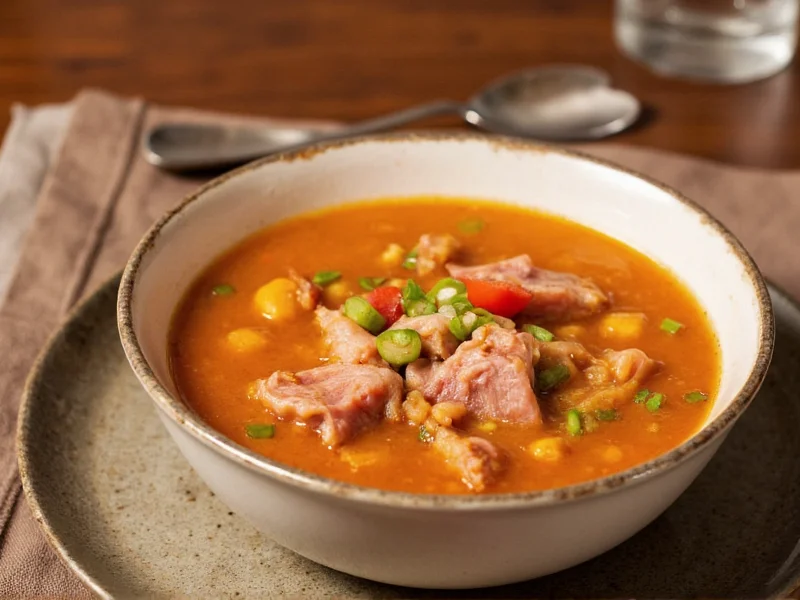Ham bone soup transforms what would otherwise be discarded into a comforting, nutrient-rich meal. This traditional preparation method dates back to times when nothing went to waste in the kitchen, and it remains popular today for both its economical use of ingredients and its deeply satisfying flavor profile. The collagen-rich bone marrow adds body to the broth while infusing it with savory ham essence that store-bought broths can't replicate.
Why This Ham Bone Soup Recipe Works
Unlike quick soup recipes that rely on bouillon cubes, this traditional ham bone soup method extracts natural gelatin and flavor compounds through slow simmering. The extended cooking time breaks down connective tissues in the bone, creating a broth with superior mouthfeel and nutritional benefits. Properly prepared ham bone soup should have a rich, slightly viscous texture that coats the spoon—a sign you've successfully extracted the bone's valuable nutrients.
Essential Ingredients for Authentic Ham Bone Soup
The magic happens through the combination of your ham bone with fresh vegetables and herbs. Here's what you'll need for the best homemade ham bone soup:
| Ingredient | Quantity | Preparation Notes |
|---|---|---|
| Ham bone with meat | 1 (about 1-2 lbs meat remaining) | Leftover from holiday ham works perfectly |
| Yellow onions | 2 medium | Diced (about 2 cups) |
| Carrots | 3 medium | Peeled and diced |
| Celery ribs | 3 | Diced with leaves reserved |
| Garlic cloves | 3 | Minced |
| Dried thyme | 1 teaspoon | Or 3 sprigs fresh thyme |
| Bay leaves | 2 | Remove before serving |
| Potatoes | 3 medium | Peeled and cubed (Yukon Gold recommended) |
| Water or low-sodium broth | 8 cups | Cover bone completely |
| Apple cider vinegar | 2 tablespoons | Helps extract minerals from bone |
Equipment You'll Need
- 8-10 quart stockpot or Dutch oven
- Wooden spoon
- Slotted spoon
- Mesh strainer
- Large bowl for straining
- Measuring cups and spoons
Step-by-Step Ham Bone Soup Instructions
Preparation (15 minutes)
- Remove any large pieces of meat from the ham bone, chop into bite-sized pieces, and set aside.
- Wash and dice all vegetables to uniform 1/2-inch pieces for even cooking.
- Place the ham bone in your stockpot.
Cooking Process (2.5-3 hours)
- Add water or broth to cover the bone completely by at least 2 inches (about 8 cups).
- Stir in apple cider vinegar, which helps extract calcium and other minerals from the bone.
- Bring to a gentle boil, then reduce heat to maintain a bare simmer (small bubbles occasionally breaking the surface).
- Cover and simmer for 2 hours, skimming any foam that rises to the top during the first 30 minutes.
- After 2 hours, add onions, carrots, celery, garlic, thyme, and bay leaves.
- Continue simmering uncovered for 45 minutes.
- Add potatoes and reserved ham pieces, then cook for another 30-45 minutes until potatoes are tender.
- Remove bone and bay leaves. Discard bone (meat should have fallen off during cooking).
- Season with salt and pepper to taste (be cautious with salt as ham adds significant sodium).
Professional Tips for Perfect Ham Bone Soup
- Skim regularly during the first 30 minutes to ensure a clear broth.
- Don't rush the simmer—the full 2-3 hours extracts maximum flavor and nutrients.
- Cool before refrigerating to prevent temperature shock to your refrigerator.
- Remove fat after chilling—the soup will solidify when cold, making it easy to remove congealed fat from the surface.
- Add fresh herbs just before serving for bright flavor notes.
Delicious Variations to Try
Once you've mastered the basic ham bone soup recipe, experiment with these popular adaptations:
- Creamy ham bone soup: Stir in 1 cup heavy cream or coconut milk during the last 15 minutes of cooking
- Bean ham soup: Add 1 cup cooked white beans or navy beans with the potatoes
- Split pea variation: Include 1 cup dried green split peas with the initial simmer for a thicker, heartier soup
- Smoky ham hock alternative: Use a smoked ham hock instead of a ham bone for more intense flavor
- Vegetable-packed version: Add diced parsnips, turnips, or leeks with the other vegetables
Proper Storage and Reheating
Ham bone soup stores exceptionally well, making it perfect for meal prep:
- Refrigeration: Store in airtight containers for up to 5 days
- Freezing: Freeze in portion-sized containers for up to 6 months (remove bay leaves first)
- Reheating: Warm gently on stove over medium-low heat, stirring occasionally
- Revitalizing: Add a splash of water or broth when reheating if the soup has thickened too much
Serving Suggestions for Your Homemade Soup
Elevate your ham bone soup experience with these serving ideas:
- Top with fresh parsley, chives, or celery leaves
- Pair with crusty bread or cornbread for dipping
- Add a dollop of sour cream for richness
- Serve alongside a simple green salad
- For a complete meal, add cooked pasta or rice directly to the soup
Why Homemade Ham Bone Soup Beats Canned Versions
While convenient, canned soups lack the depth of flavor and nutritional benefits of homemade ham bone soup. Commercial versions often contain excessive sodium, preservatives, and artificial flavors while missing the collagen-rich broth that comes from proper bone simmering. Your homemade version controls the sodium content, contains no additives, and provides valuable nutrients extracted from the bone that support joint health and digestion.











 浙公网安备
33010002000092号
浙公网安备
33010002000092号 浙B2-20120091-4
浙B2-20120091-4